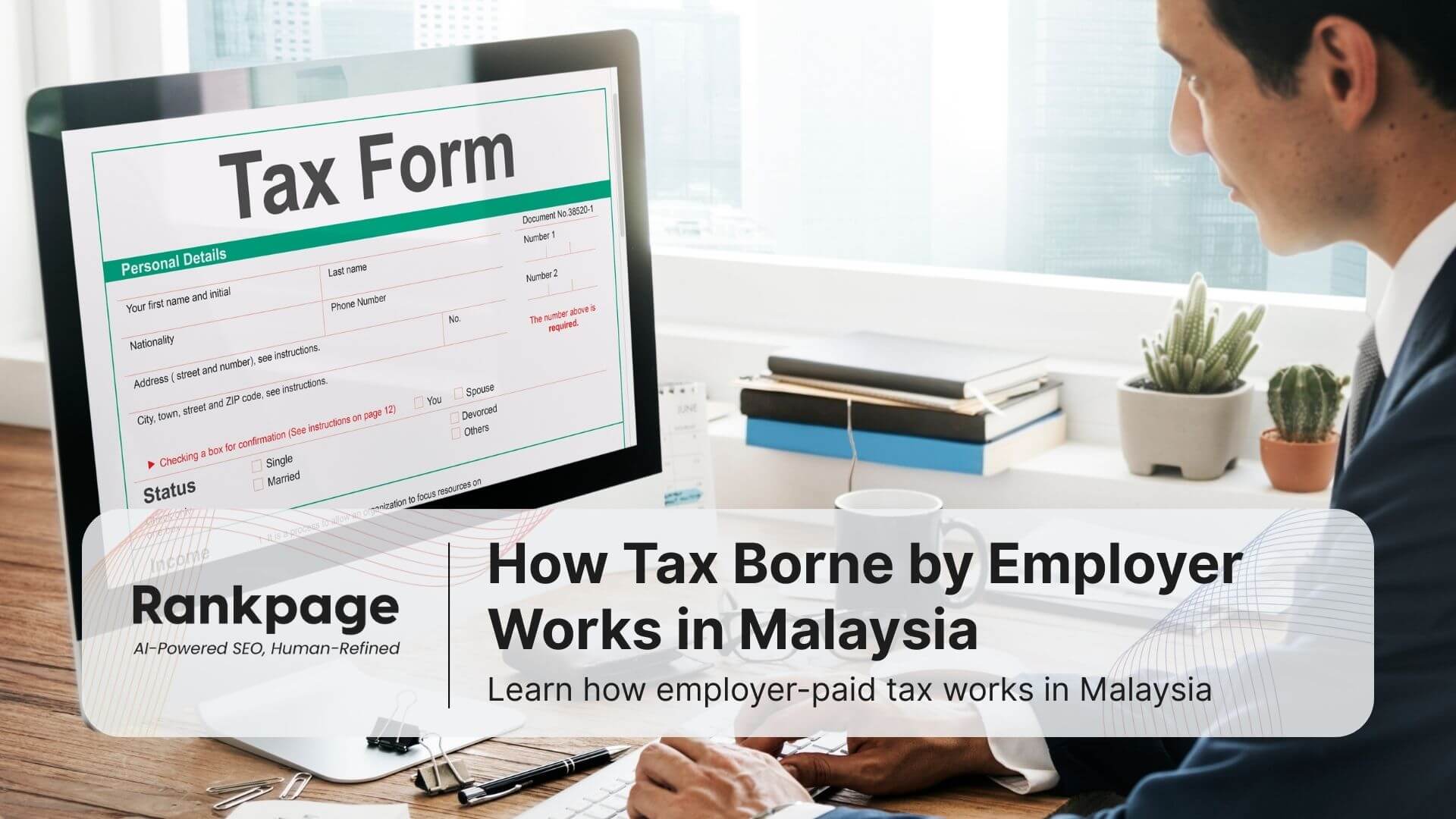Key Takeaways
- Tax borne by employer means the company pays the employee’s income tax instead of deducting it from salary.
- Under Section 13(1)(a) of the Income Tax Act 1967, perquisites, including employer‑paid tax, are considered taxable employment income
- Employers must use the grossing-up method for accurate PCB and total taxable income calculation.
- Compliance involves updating PCB deductions, EA Forms, and CP39 submissions.
- Non-compliance can lead to penalties of up to 300% of the underpaid tax.
Tax borne by the employer means the company pays part or all of an employee’s income tax, so the employee takes home their full salary without deductions for tax.
It’s a generous benefit that can help attract and keep talent, but there’s a catch. The tax the company covers is itself taxable, which means employers (HR teams take note) pay more than just the original tax bill.
For employees, it’s a win. For employers, not so much. One wrong step, and LHDN could send you more than just a friendly letter.
But don’t worry, today, we will explain how employer-paid tax works in Malaysia, what it means and what employers need to know.
Table of Contents
What Does Tax Borne by Employers Really Mean
In practical terms, the employer absorbs the income tax cost, allowing the employee to take home their entire agreed salary.
This means:
- LHDN treats that payment as extra income for the employee.
- This extra income is added to their taxable salary.
- The following year, they’ll be taxed on that extra amount too, this is called the tax-on-tax effect.
In other words, paying RM5,000 in tax for someone isn’t just RM5,000 out of your budget, it’s more once you factor in the gross-up.
- This benefit must be reported in the EA Form as part of the employee’s total income.
- It applies whether the tax is paid in full or partially.
It’s commonly offered for executive compensation packages to attract senior talent or retention offers for high-value employees in competitive industries.
Verified: Public Ruling No. 3/2024 was issued 10 Dec 2024 and updates No. 11/2016.
The Tax-on-Tax Effect for Employers
When a company pays an employee’s income tax, LHDN treats that payment as additional income for the employee. This has a compounding effect:
- The taxable income figure increases.
- The additional amount is subject to tax.
- The actual cost ends up higher than the original tax bill.
It’s akin to stacking dominos, one payment triggers another tax charge, and it keeps adding up.
Example: Full Tax Coverage
Scenario:
- Annual Salary: RM72,000 (RM6,000/month)
- Personal Reliefs: RM9,000
- Income Tax: RM4,800
- Tax rate 8% = RM417.39
- Total Employer Cost: RM4,800 + RM417.39 = RM5,217.39
Covering RM4,800 in tax actually costs you 8.7% more than the tax amount itself.
Example: Partial Coverage for a Bonus
Scenario:
- Annual Salary: RM72,000 (RM6,000/month)
- Bonus: RM12,000 (employer covers tax on bonus)
- Personal Reliefs: RM9,000
- Tax on Bonus: RM800
- Tax Rate: 8%
Calculation:
- Gross-Up = RM800 × [0.08 ÷ (1 – 0.08)] = RM69.57
- Total Cost to Employer: RM800 + RM69.57 = RM869.57
Takeaway: Even for one-off payments like bonuses, gross-up can push your cost 9% higher.
Tax Bill Covered | Tax Rate | Gross-Up Cost | Total Employer Cost |
RM2,000 | 8% | RM173.91 | RM2,173.91 |
RM5,000 | 8% | RM434.78 | RM5,434.78 |
RM10,000 | 8% | RM869.57 | RM10,869.57 |
Tip for Finance & HR: Always gross-up before you commit to “tax coverage.” The difference may look small per employee, but across multiple hires, it can be a serious budget jump.
Read more: Sdn Bhd / Sole Proprietorship / LLP: Which One Right for You?
Impact on PCB and Payroll
When an employer pays tax on behalf of an employee, that amount is treated as extra income by LHDN.
This has two direct effects:
- Increased PCB deductions in the next Year of Assessment (YA).
- Higher reported income on EA Forms and CP39 submissions.
For Payroll Teams You have to Do:
- PCB Adjustments: Even if the employee’s salary stays the same, PCB in the next YA will be higher because the tax coverage from the previous year is added to their income.
- Compliance Checks: If payroll fails to include the covered tax in EA Forms, it can trigger penalties during audits.
- Forecasting Costs: Covering RM10,000 in tax isn’t just RM10,000; the gross-up increases total payroll expenses.
Example: Full Coverage
Item | Amount (RM) |
Annual Salary | 60,000 |
Tax Paid by Employer | 2,130.43 |
Total Income Declared to LHDN | 62,130.43 |
PCB Adjustment in Next YA | Higher PCB based on total income |
Example: Partial Coverage
Item | Amount (RM) |
Annual Salary + Allowance | 70,000 |
Tax Portion Covered by Employer | 440.98 |
Total Income Declared to LHDN | 70,440.98 |
PCB Adjustment in Next YA | Increase only for covered portion |
Why This Matters for Employers
- Forecasting Payroll Costs: Covering RM10,000 in tax isn’t just RM10,000; the gross-up inflates your total payroll expense.
- Avoiding Penalties: If payroll fails to include employer-paid tax in EA Forms or CP39, LHDN can impose penalties of up to 300% of the underpaid amount.
- Year-End Workload: Your HR/payroll team will need to adjust PCB tables, recheck payslips, and make sure every form reflects the correct taxable amount.
“Always review payroll software settings after introducing tax coverage to make sure PCB and EA reporting update automatically. Manual oversight here is where most mistakes happen.”
How to Calculate Employer-Paid Tax (Grossing-Up Method)
The gross-up method makes sure the tax employers pay covers the full intended benefit to the employee, without them losing part of it to more tax.
Think of it like topping up a drink:
If you just pour the exact tax amount, the “glass” (net benefit) won’t be full because some gets taxed again. Grossing-up is adding a bit more so it stays full.
Formula:
Employer Tax = Notional Tax × [Tax Rate ÷ (1 – Tax Rate)]
* Notional Tax = The original tax amount you’re covering
* Tax Rate = The employee’s applicable tax bracket (as a decimal, e.g., 8% = 0.08)
Example (Full Coverage)
- Annual Salary: RM60,000
- Personal Reliefs: RM8,000
- Notional Tax: RM1,960
- Gross-Up: RM1,960 × [0.08 ÷ (1 – 0.08)] = RM170.43
- Total Employer Tax: RM2,130.43
We always recommend using the current LHDN tax rate table schedule for accuracy.
- If you skip grossing-up, the employee ends up with less than the intended benefit.
- It’s the only method LHDN accepts for correctly reporting employer-paid tax.
- Your PCB, EA Form, and CP39 submissions all rely on getting this right. So, get it right.
Employer Compliance Checklist: Tax Borne by Employer
Step | What to Do | Why It Matters |
1. Calculate Gross-Up | Use correct LHDN formula: Employer Tax = Notional Tax × [Tax Rate ÷ (1 – Tax Rate)] | Ensures the employee gets the full intended benefit and meets LHDN reporting rules. |
2. Update PCB for Next YA | Adjust monthly Potongan Cukai Berjadual to reflect the extra taxable income from tax coverage. | Prevents under-deduction and surprise tax bills. |
3. Declare in EA Form | Record as “Tax Borne by Employer” under perquisites/benefits. | Mandatory for accurate annual reporting. |
4. Submit Revised CP39 | If tax coverage changes mid-year, update CP39 submission to LHDN. | Keeps payroll compliance in real-time. |
5. Keep Signed Agreements | Document any tax coverage terms with employees. | Protects against disputes during audits. |
6. Annual Tax Review | Recheck coverage costs and methods with a tax consultant each year. | Keeps calculations current and reduces risk of penalties. |
Penalties for Non-Compliance
If employer-paid tax is not declared correctly in EA Forms, PCB deductions, or CP39 submissions, LHDN may treat this as under-declaration of income.
Under Section 113(2) of the Income Tax Act 1967, LHDN can impose:
- A fine between RM1,000 and RM10,000, and
- A penalty of up to 300% of the tax undercharged.
The actual penalty rate depends on the case, genuine reporting mistakes may attract a lower percentage, while deliberate non-reporting can lead to the maximum 300% penalty.
Example: If RM10,000 in tax coverage was not reported, LHDN could impose a penalty of up to RM30,000 in addition to the unpaid tax.
Common Mistakes Employers Make (and How They Get Penalised)
Ignoring the tax-on-tax effect
Many companies budget only for the tax amount itself, forgetting that LHDN treats it as additional income and taxes it again. This means a “RM10,000 tax coverage” could actually cost closer to RM10,869 once gross-up is factored in.
Declaring in the wrong Year of Assessment
If the covered tax is reported in the wrong YA, it creates a mismatch between PCB deductions and the EA Form. This often triggers LHDN queries and, in some cases, demands for back payments.
Miscalculating partial coverage
When an employer covers only part of an employee’s tax, the covered amount must be calculated accurately. Even a small under-reporting (RM2,000 covered but only RM1,600 declared) can be treated as under-declaration.
Skipping EA Form reporting
This is one of the fastest ways to land in an audit. LHDN cross-checks bank payments with EA Forms, and if covered tax is missing from the declaration, penalties of up to 300% can apply.
Not updating PCB after policy changes
When a company switches from partial to full coverage (or vice versa), PCB schedules must be updated immediately. If they aren’t, deductions will be too low and employees may face unexpected arrears.
“Maintain a simple “tax coverage tracker” in payroll records, listing the amount covered, the gross-up applied, and the date it was reported to LHDN. It can be a lifesaver during audits.”
Conclusion: Tax Borne by Employer in Malaysia
Employer-paid tax can be a real win-win, employees enjoy their full salary without deductions, and employers can use it as a sweetener in competitive hiring markets.
The catch? It’s only a perk if it’s handled properly.
A few extra minutes spent on accurate gross-up calculations and clear reporting can save months of headache later. Get it right, and you’ve got a benefit that feels generous, works smoothly, and leaves everyone, including LHDN, happy.
Want this kind of compliance content to rank and bring in qualified leads?
At Rankpage, we specialise in turning tax and HR topics into top-performing search assets with SEO and top tier digital marketing tactics.
Let’s optimise your pages so they show up first, and convert.
Disclaimer: All of the content was thoroughly fact-checked and verified by our editorial team to ensure accuracy, clarity, and reliability.
Frequently Asked Questions About Tax Borne by Employers
What Is “Borne” In Tax Terms?
It means one party assumes the payment responsibility, “borne by employer” means the company pays it for the employee.
Is Employer-Paid Tax Subject To Epf?
No. EPF is based on wages, not on employer-paid tax.
Can Employer-Paid Tax Be Claimed As A Business Expense?
Yes, it is deductible as a staff cost.
Does It Apply To Foreign Employees?
Yes, but check double tax agreements.
What If It’s Not Declared?
LHDN may impose penalties of up to 300% of underpaid tax.
How Do You Gross-Up For Tax Absorption?
Multiply the notional tax by [Rate ÷ (1 – Rate)].





